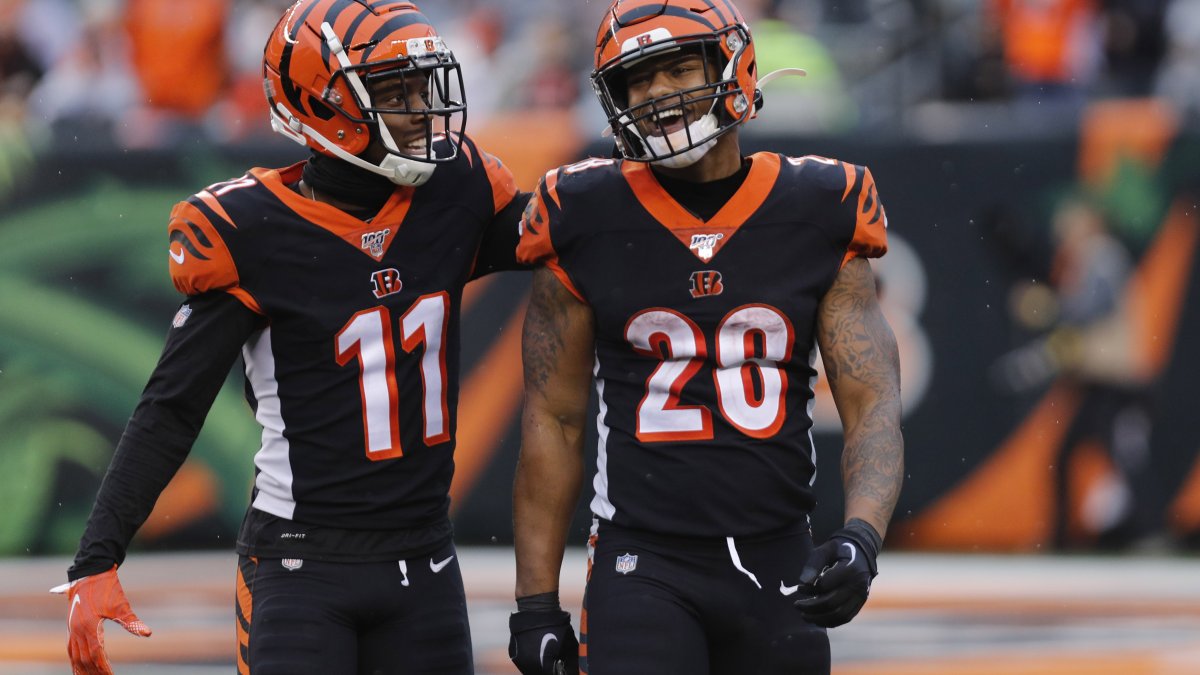Cincinnati Bengals running back Joe Mixon solidified his future this week when he agreed to terms on a four-year deal worth $48 million.
A 2017 second-round pick, Mixon was always seen as one of the most talented players in his draft class, but off-field concerns and legal issues saw him slide. And while he has been a solid player for Cincinnati since he came into the league, he has still yet to hit spectacular heights.
His overall PFF grade has hovered around in the 70s, with his career-high coming in 2018 (77.8) and his career-low coming during his rookie year (72.6). And for as much as he hasn't had the best situation to work with — the run blocking in front of him — he hasn't particularly excelled in the areas that running backs have the most influence over.
Since entering the league, Mixon has averaged 2.8 yards after contact per carry, which ranks just 24th among players with at least 250 carries over that time. He fares slightly worse in terms of avoiding tackles from defenders, with his 100 broken tackles on 692 attempts ranking 31st over that time.
Mixon brings some value as a capable receiver out of the backfield, making him an every-down back in the eyes of many at draft time, but he has earned a PFF receiving grade of just 62.1 during his time in the NFL. And yes, he has been more likely to break tackles after the catch (19 on 108 receptions), but he hasn't consistently been the big-play threat he was expected to be, and his yards per route run figure of 1.29 ranks 31st out of 66 qualifying running backs over the last three seasons.
Mixon was expected to be a bell-cow running back given his skill set and size (6-foot-1, 220 pounds), but the clearest place that has manifested itself so far is in playing time and cumulative yardage figures. Though Mixon is the No. 4 ranked rusher in terms of yardage total since entering the league, he is eighth in PFF rushing grade and 13th in PFF overall grade. At just 24 years old, there is still plenty of reason to believe that his best football can be ahead of him, but he is a good example of a player whose talent has been capped by the lack of help he has around him.
The Bengals have now invested in Mixon with the belief that he can consistently rank among the top five running backs in the game, but they now need to give him the blocking to let that happen as well as hope that improvement leads to an uptick in Mixon's individual metrics.
With Mixon, Joe Burrow and a good group of receivers in place, the Bengals have a talented stable of skill position players that they will need in order to succeed for the next few years. Still, their offensive line is a concern that could put a ceiling on how well any of them performs in the short term.
Breaking down the contract
The deal lands about where we would've expected it to, as Mixon has the draft pedigree from being a former second-round pick. Mixon's $12 million average per year now slots in just behind Tennessee Titans back Derrick Henry at $12.5 million per year, making the Bengals' workhorse the sixth-highest-paid running back in the NFL on a per-year basis.
This is a fair deal for Mixon, who some may have expected to push for more. He belongs in this second tier of running backs who aren't as versatile as the Christian McCaffreys and the Alvin Kamaras of the league. Unlike McCaffrey and Kamara, Mixon does not pose as a truly legitimate threat when lined up in the slot or on the outside, and when he does get opportunities to line up out of the backfield, he is mostly used as a decoy.
His greatest weakness may come when the ball isn't in his hands — and it's something he'd better correct quickly now that Burrow is under center in Cincinnati — as Mixon has been a pedestrian pass-blocker (to put it kindly) up to this point in his career. However, his 2019 pass-blocking grade of 64.6 was by far the highest of his three-year career, so perhaps there is room for optimism.
With Zac Taylor likely pushing for even more 11-personnel usage in Cincinnati, Mixon will have to improve his blocking skills — the trio of A.J. Green, Tyler Boyd and John Ross provide a capable receiving group (and that's not to mention Tee Higgins and Auden Tate as reliable depth), but Burrow will still need time to find his receivers open downfield.
From our vantage point, this deal means a lot to one player in particular: Minnesota Vikings back Dalvin Cook.
As we've expressed, we don't view Mixon in the same tier as Alvin Kamara, so we don't see this deal affecting those negotiations. However, the Vikings selected Cook with the 41st pick of the 2017 NFL Draft, just seven draft slots ahead of Mixon, and the two have a similar playing style. The key difference: Mixon has missed four games due to injury in three seasons, while Cook has been sidelined for 19. Even though it would be fair to argue that Cook is the better player, he isn't so much better than Mixon that he should now be asking for much more than $12 million per year. At this point, though, following the Yannick Ngakoue trade, Minnesota may no longer be negotiating with Cook anyway.



 © 2024 PFF - all rights reserved.
© 2024 PFF - all rights reserved.